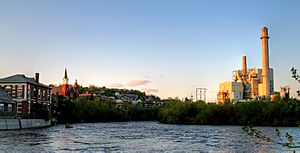Mill town facts for kids
A mill town is a special kind of town that grew up around one or more large factories or "mills." These mills usually made things like cotton cloth or other textiles (fabrics). People moved to these towns to work in the factories, and everything in the town, from homes to shops, was built to support the mill and its workers. Mill towns are also sometimes called factory towns or mill villages.
Contents
Mill Towns in Europe
Italy's Historic Mill Towns
Italy has some interesting old mill towns. One famous example is Crespi d'Adda, which is so well-preserved that it's a UNESCO World Heritage Site. This means it's a very important place to protect because of its history.
Poland's Textile History
Żyrardów: A Unique Factory Town
The town of Żyrardów in Poland started with a textile factory in 1833. It was built by the sons of Feliks Lubienski. They brought in a French inventor named Philippe de Girard to help with new machines. The town was even named after him!
Żyrardów became a very important textile town in Poland during the 1800s. What's amazing is that most of its old factory buildings and homes from the 19th and early 20th centuries are still there. It's thought to be the only complete industrial town from that time period still standing in Europe.
United Kingdom's Mill Towns
In the United Kingdom, when people say "mill town," they usually mean the towns in northern England and Scotland that grew because of textile factories in the 1800s. Places like Lancashire were famous for cotton, and Yorkshire for wool.
Many of these towns still show their textile history. Some have symbols of the industry on their town badges. Others might have statues honoring the textile workers who lived and worked there.
- Lancashire had many cotton mill towns, like Blackburn and Burnley.
- Yorkshire was known for wool, with towns such as Bradford and Halifax.
It's important to remember that not all "mill towns" only had textile factories. For example, Wigan in Greater Manchester was also a big mining town.
Mill Towns in North America
United States: A Manufacturing Powerhouse

In the United States, especially in New England, many mill towns popped up in the 1800s. This happened after people like Samuel Slater and Francis Cabot Lowell brought new factory ideas from England.
These towns often grew along rivers like the Merrimack or Blackstone. The rivers provided the power needed to run the big machines in the mills. Sometimes, the factory owners even built and owned the whole town, which were called company towns.
However, things changed in the 1900s. New ways to power factories were invented, so mills didn't need to be next to rivers anymore. It also became cheaper to make textiles in southern states because cotton was grown there, and heating costs were lower in winter. The Great Depression in the 1930s also caused many New England mills to close down.
New England and Northeast Mill Towns
Many states in the Northeast had mill towns.
- Connecticut had towns like Willimantic and Waterbury.
- Massachusetts was home to famous mill towns such as Lowell and Lawrence.
- New Hampshire had places like Manchester and Nashua.
- Rhode Island included Pawtucket and Woonsocket.
Southern Mill Towns
The textile industry also moved south.
- Alabama had mill towns like Sylacauga.
- North Carolina saw towns like Kannapolis and Burlington grow.
- South Carolina had places such as Fort Mill and Ware Shoals.
Sawmill Towns
Besides textile mills, some towns grew around sawmills, which cut down trees to make lumber.
Mill Towns in South America
Colombia's Industrial Past
- San José de Suaita in Colombia is an example of a mill town in South America.
See also
- Company town
- Industrial district
Images for kids


















